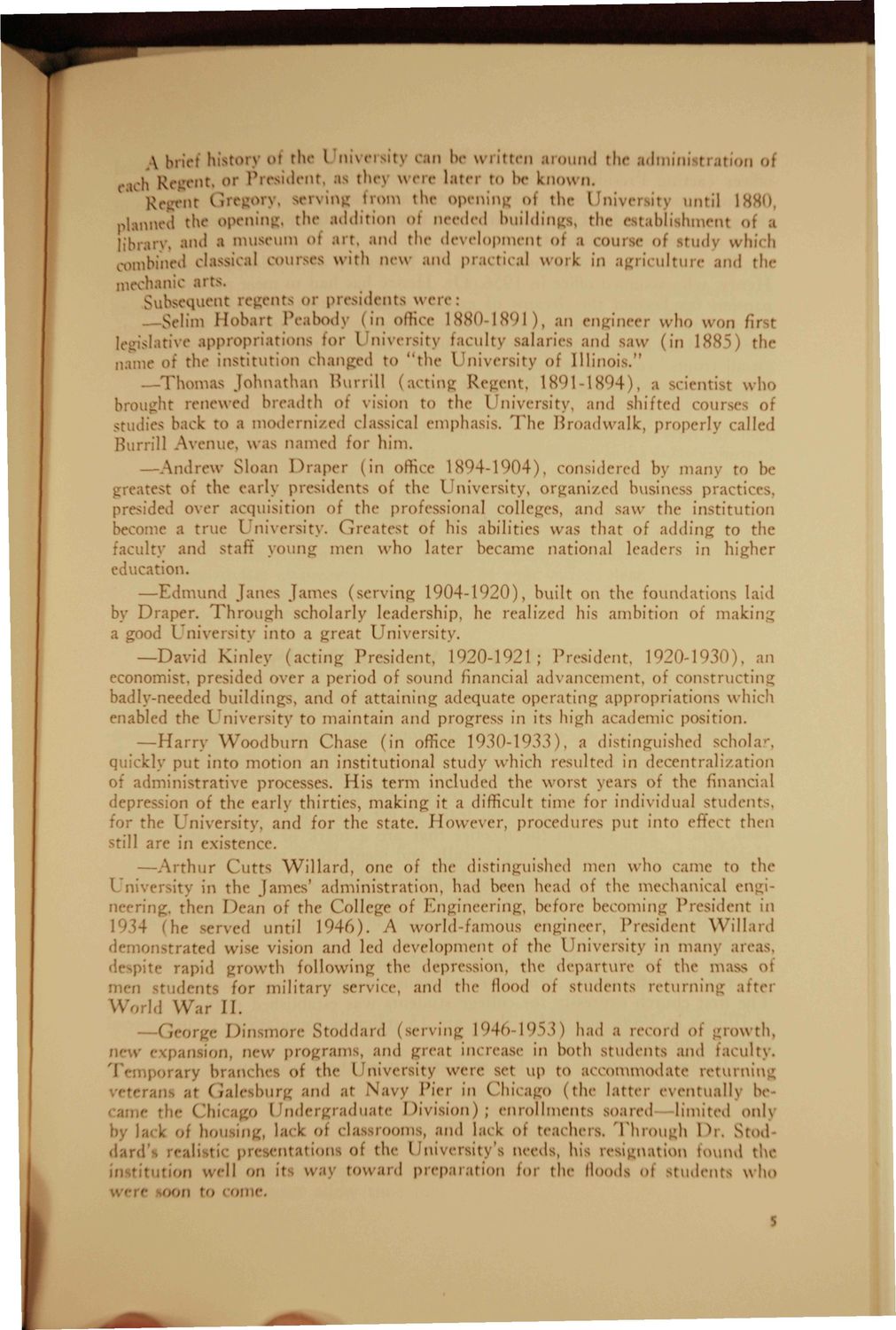Caption: Student Regulations - Undergraduates - 1961
This is a reduced-resolution page image for fast online browsing.

EXTRACTED TEXT FROM PAGE:
A brief historj ol the university can he written around the administration ( etch Regent, or President, as they were lam- to he known. Regent Gregory, serving from the opening oi the University until i8Hn planned the opening, the addition oi needed buildings, the establishment oi library, ami a museum oi art. and the development of a course of study which combined classical courses with new and practical work in agriculture and the mechanic arts. Subsequent regents or presidents were: .—Selim Hobart Peabody (in office 1880 1891), an engineer who won first \c dative appropriations tor I niversitv faculty salaries and saw (in 1885) the name oi the institution changed to "the University of Illinois." —Thomas Johnathan Burrill (acting Regent, 1891-1894), a lentist who >ught renewed breadth of vision to the University, and shifted courses of studies hack to a modernized classical emphasis. The Broadwalk, properly called Burrill Avenue, was named tor him. — A n d r e w Sloan D r a p e r (in office 1894-1904), considered by many to he itest of the early presidents of the University, organized business practices presided over acquisition of the professional colleges, and saw the institution become a true I n i v e r s i t y . Greatest of his abilities was that of adding to the ulty and staff young men w h o later hecame national leaders in higher education. — E d m u n d Janes J a m e s (serving 1 9 0 4 - 1 9 2 0 ) , built on the foundations laid by Draper. T h r o u g h scholarly leadership, he realized his ambition of making a % University into a great University. — D a v i d Kinley (acting President. 1920-1921; President. 1920-1930), an economist, presided over a period of sound financial advancement, of constructing badly-needed building-, and of attaining adequate operating appropriations which enabled the University to maintain and progress in its high academic position. — H a r r y W o o d b u r n Chase (in office 1930-1933), a distinguished scholar, quickly put into motion an institutional study which resulted in decentralization of administrative processes. H i s term included the worst years of the financial depression of the early thirties, making it a difficult time tor individual students. the University, and for the state. H o w e v e r , procedures put into effect then ill are in existence. — A r t h u r CuttS W i l l a r d . one of the distinguished men who came to the University in the James' administration, had been head of the mechanical engineering. then Dean of the College of Engineering, before becoming President in 1934 (he served until 1 9 4 6 ) . A world-famous engineer, President W i l l a r d d' Itrated w. vision and led development of the University in many areas. despite rapid growth following the depression, the departure of the mass of •n • identS for military service, and the flood of students returning alter W o r l d W a r II. —(Jeorge Dinsmore Stoddard (serving 1946 1953) had a record oi growth, new expansion, new programs, and great increase in both students and faculty. 'I nporary branches of the 1 University were set up to accommodate returnin i< Galesburg and at Navy Pier in Chicago (the latter eventually b •! < came the Chicago Undergraduate Division); enrollments soared limited onlj b. lack or housing, lack of classrooms, and lack of teachers. T h r o u g h P i . ^tod dard's realistic p ' r o t a t i o n , oi t\w University's needs, his resignation found the if iturion well on its way toward preparation for the floods « t students who » on to i ome, 5 Were
|